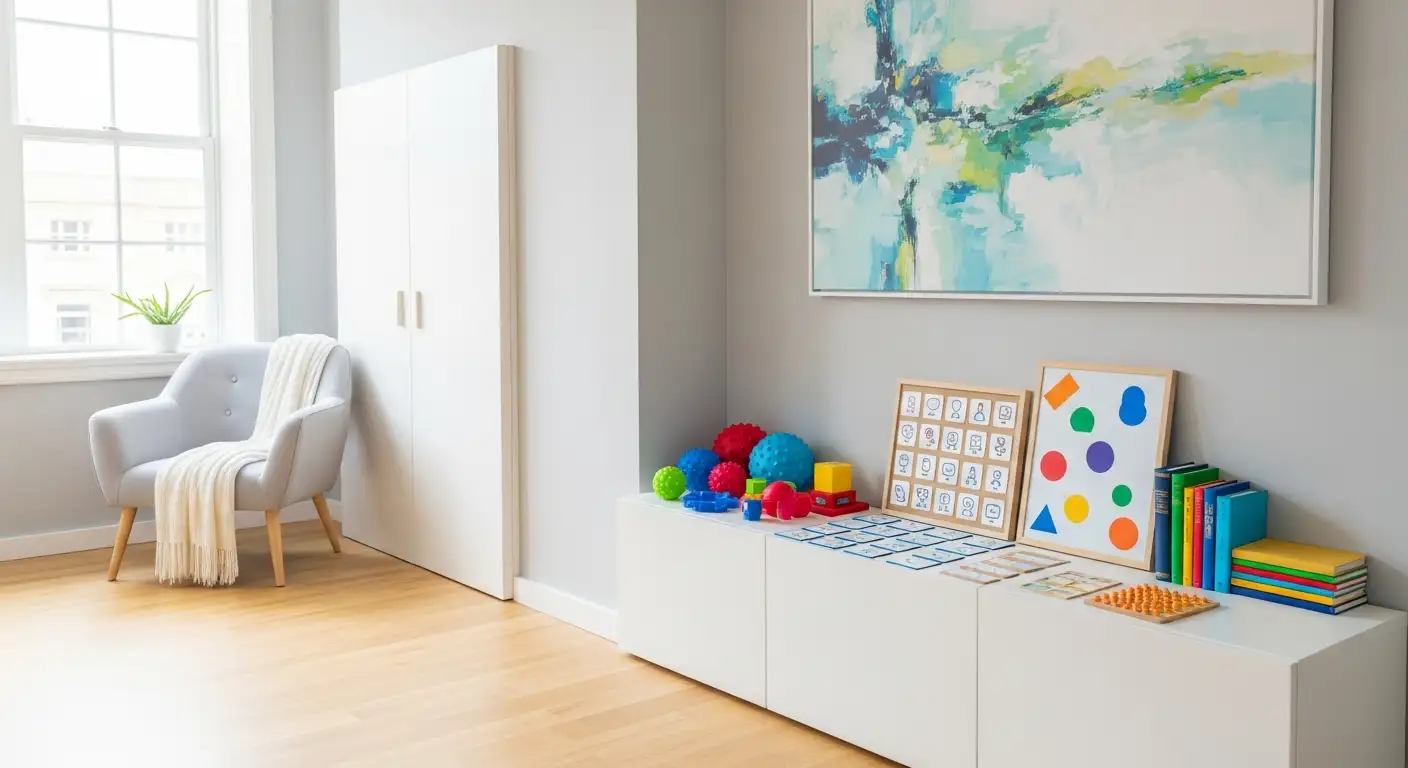In today's digital age, technology is an inescapable part of daily life. Children, including those with autism spectrum disorder (ASD), are surrounded by screens from a very young age. From smartphones and tablets to laptops and televisions, screens have become an integral part of the modern childhood experience. While technology offers numerous benefits in terms of entertainment, education, and communication, it can also have a significant psychological impact, particularly for children with autism, presenting unique challenges that parents and caregivers need to address.
Let's delve deeply into the psychological impact of screen time on children with autism and provide parents with crucial insights. By understanding how technology affects these children, parents can make more informed decisions about their child’s screen use and adopt effective strategies for creating a balanced digital environment.
Autism Spectrum Disorder and Screen Time: An Overview
Before diving into the psychological impacts of screen time, it’s essential to understand how autism spectrum disorder (ASD) may influence the way children with autism interact with technology. Autism is a complex neurodevelopmental disorder that affects communication, social interaction, and behavior, and these characteristics can shape a child’s relationship with screens in unique ways.
Understanding the Spectrum of Autism
Autism is often referred to as a "spectrum" because it encompasses a wide range of abilities and challenges. Some children may be non-verbal and struggle significantly with communication, while others may have advanced language skills but experience difficulty understanding social cues. Additionally, children on the spectrum may exhibit repetitive behaviors, sensory sensitivities, and a need for structured routines, all of which can influence how they use and respond to technology.For example, a child who is highly sensitive to sensory stimuli might find comfort in certain apps or videos that provide a controlled, predictable environment. In contrast, another child might become overstimulated by the flashing lights and fast-paced content of some online platforms.
How Technology Can Be a Tool for Children with Autism
Technology, when used thoughtfully, can be a powerful tool for children with autism, particularly in areas where they experience communication barriers. Apps designed to support Augmentative and Alternative Communication (AAC) can give non-verbal children a voice, enabling them to express their needs and emotions through pictures, symbols, or text-to-speech features. These tools can bridge the gap between the child and their environment, facilitating interactions with peers, teachers, and family members.Additionally, children on the autism spectrum often find comfort in structure and repetition. Many digital platforms, such as educational apps or certain video games, provide predictable outcomes and clear rules, which align with the cognitive strengths of some children with autism. These features can support cognitive development by reinforcing problem-solving skills, memory retention, and even social-emotional learning, depending on the nature of the activity.
The Benefits of Screen Time for Children with Autism
While the focus is often on the negative aspects of screen time, it’s important to acknowledge the potential benefits, particularly for children with autism. With the right structure and guidance, screen time can be an invaluable tool for development and learning.
1. Enhanced Communication Skills
Many children with autism face challenges in verbal communication, and some may be non-verbal entirely. For these children, certain apps and technologies can offer alternative ways to communicate. Augmentative and Alternative Communication (AAC) devices or apps can help non-verbal children express their needs, thoughts, and feelings through text or pictures.For example, apps that provide visual prompts can help children with autism better understand everyday tasks or navigate social situations. These tools can serve as a bridge, helping children communicate with parents, teachers, and peers in ways that they might not be able to otherwise.
2. Development of Cognitive Skills
Interactive games and educational apps can offer cognitive challenges that are both entertaining and developmentally appropriate for children with autism. Many children on the spectrum gravitate toward technology because it offers predictable outcomes, a sense of control, and immediate feedback. This structure can be especially helpful for children who thrive in environments with clear rules and routines.These apps can help develop skills like problem-solving, logical thinking, and memory. In many cases, the repetitive nature of certain games or tasks is appealing to children with autism, as it mirrors the repetitive behaviors often seen in autism, offering a comforting sense of familiarity and routine.
3. Reduced Sensory Overload
Many children with autism are hypersensitive to stimuli in their environments, whether it’s bright lights, loud noises, or crowded spaces. Technology, particularly the use of tablets or smartphones, can offer a form of sensory control. A child can interact with the screen in a quieter, more controlled space, reducing the likelihood of sensory overload.In this context, screens can offer a form of escapism that might be necessary for some children with autism, providing a buffer against a world that feels overwhelming.
4. Opportunities for Social Interaction
Online platforms, games, and apps can offer children with autism a chance to interact socially in ways they might not feel comfortable doing in person. Video games that include cooperative play or social networking apps can provide opportunities to connect with others in a structured and less intimidating way. For some children with autism, these interactions can be a gateway to building friendships and practicing social skills.However, while these benefits are significant, it’s important to acknowledge the potential risks and negative psychological impacts of excessive screen time.
The Risks of Excessive Screen Time for Children with Autism
As beneficial as technology can be, too much screen time can have detrimental effects on the psychological well-being of children with autism. Understanding these risks is essential for parents who want to create a balanced approach to technology in their child’s life.
1. Social Isolation and Withdrawal
One of the most significant risks associated with excessive screen time is social isolation. Children with autism may already struggle with social skills, and prolonged screen time can further reduce the opportunities they have for real-life social interactions. Over-reliance on screens can lead to a withdrawal from family, friends, and peers, which may deepen feelings of loneliness or alienation.For example, a child who spends hours playing video games might miss out on valuable opportunities to engage in face-to-face communication, make eye contact, or interpret non-verbal cues—all crucial skills for developing social competence. Over time, this can result in a child becoming more withdrawn, which could further hinder their social development.
2. Sleep Disruptions
Research has consistently shown that excessive screen time, particularly before bed, can interfere with sleep. This is due to the blue light emitted by screens, which can suppress melatonin production, the hormone that regulates sleep.Children with autism are already more likely to experience sleep disturbances, such as difficulty falling asleep or staying asleep throughout the night. Adding excessive screen time into the mix can exacerbate these issues, leading to a vicious cycle of poor sleep and heightened anxiety, mood swings, or behavioral issues.
3. Increased Anxiety and Stress
For children with autism, who may already be prone to anxiety, excessive screen time can heighten feelings of stress. The constant stimuli provided by screens—flashing lights, fast-moving images, and rapid sound effects—can overwhelm a child’s sensory system, leading to increased anxiety.Moreover, the content children consume on screens can also contribute to feelings of stress. For example, video games that are highly stimulating or violent can trigger frustration, especially if the child struggles with impulse control. Additionally, the fast-paced nature of many digital environments may cause children to feel anxious or stressed when they’re unable to keep up.
4. Attention and Focus Issues
Children with autism often exhibit difficulty with attention and focus, and excessive screen time can exacerbate these issues. The instant gratification provided by screens can make it challenging for children to engage in activities that require sustained attention or patience.For example, children who spend a significant amount of time playing video games or watching YouTube videos may become accustomed to rapid-fire entertainment and struggle to concentrate on tasks like reading, completing homework, or even engaging in creative play. This shortened attention span can hinder their ability to succeed in school and in other areas of life that require focus and persistence.
5. Reinforcement of Repetitive Behaviors
Children with autism often engage in repetitive behaviors or interests, known as "stimming," as a way to cope with sensory overload or to comfort themselves. While some repetitive behaviors are harmless, excessive screen time can reinforce negative stimming behaviors, such as repetitive hand movements, fixations on specific video game characters, or the need to watch the same video repeatedly.This over-reliance on screens to manage stimming can reduce a child’s ability to self-regulate and may lead to increased behavioral issues when the screen is taken away or limited.
How to Create a Healthy Screen Time Balance
Given the potential benefits and risks, it’s clear that the key to healthy screen time for children with autism is balance. Here are some strategies parents can implement to ensure their child gets the most out of their screen time while minimizing the negative psychological impacts.
1. Set Clear Screen Time Limits
One of the most effective ways to manage screen time is by setting clear limits. The American Academy of Pediatrics recommends no more than one hour of screen time per day for children aged 2 to 5 years and consistent limits for older children. For children with autism, these limits should take into account their specific needs and behaviors.For example, parents may choose to allow more screen time if their child is using technology for educational purposes or communication. However, it’s important to ensure that screen time doesn’t become a substitute for real-life interactions or other important activities, such as physical exercise or creative play.
2. Prioritize Quality Over Quantity
Not all screen time is created equal. Instead of focusing solely on the amount of time your child spends in front of a screen, pay attention to the quality of the content they are engaging with. Educational apps, communication tools, and interactive games that encourage critical thinking or problem-solving are preferable to passive content, such as watching television shows or YouTube videos.It’s also important to choose content that aligns with your child’s developmental stage and interests. For example, an app that teaches social skills or provides visual aids for communication might be more beneficial than a video game with little educational value.
3. Encourage Screen-Free Activities
To ensure that screen time doesn’t dominate your child’s day, it’s important to encourage a variety of screen-free activities. Physical activity, in particular, is crucial for children with autism, as it helps regulate mood, reduce anxiety, and improve focus. Encourage outdoor play, exercise, or other activities that engage your child’s body and mind.In addition to physical activities, consider incorporating more creative and social activities into your child’s routine. Playing with toys, drawing, or engaging in imaginative play can help children with autism develop important cognitive and social skills that screens cannot provide.
4. Model Healthy Screen Use
Children, including those with autism, learn by observing the behavior of the adults around them. If parents spend a lot of time on their phones or watching TV, children are likely to follow suit. Modeling healthy screen habits—such as setting limits on your own screen use, prioritizing face-to-face interactions, and engaging in screen-free activities—can have a positive impact on your child’s relationship with technology.
5. Create a Screen Time Schedule
A structured routine is often essential for children with autism, and this applies to screen time as well. Creating a screen time schedule can help your child understand when it’s appropriate to use screens and when it’s time to engage in other activities. This schedule should include designated times for screen use, as well as limits on how long your child can spend on specific devices or apps.
6. Use Technology as a Tool for Connection
Instead of viewing screen time as a solitary activity, consider using technology as a way to connect with your child. Co-viewing or co-playing with your child allows you to engage with them in a meaningful way while they are using screens. This can also help you better understand the content they are consuming and provide opportunities for teaching moments.For example, if your child is playing an educational game, you can join them and ask questions to reinforce the learning. If they are watching a video, you can pause to discuss what’s happening and help them process the information in a deeper way.
Striking the Right Balance for Children with Autism
Given the varied ways in which autism manifests, it’s essential for parents to carefully monitor and moderate their child’s screen time. What works well for one child may not work for another, and finding the right balance often requires trial and error. Ensuring that technology serves as a complement to, rather than a replacement for, social and physical activities is key.
Creating a Positive Screen Time Routine with Double Care ABA
Screen time is an inevitable part of modern childhood, and for children with autism, it can offer both benefits and challenges. By understanding the psychological impact of screen time and implementing strategies for balance, parents can help their children navigate the digital world in a healthy way.At Double Care ABA, we understand the unique needs of children with autism and are committed to supporting families in creating positive, balanced environments that promote growth and well-being. We encourage parents to approach screen time thoughtfully, keeping their child’s individual needs in mind, and to seek guidance from professionals when necessary.If you’re concerned about the impact of screen time on your child or want to learn more about our services, reach out to Double Care ABA for personalized support and resources.














